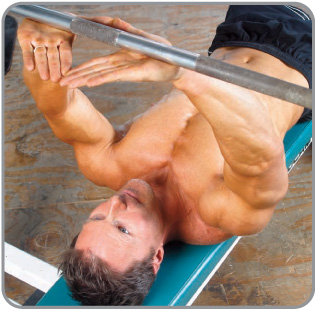
CONTENTS
• Armed and Dangerous (the ‘Strong as You Look’ Series)
• The Top Ten Russian Arm Training Secrets
• Russian powerlifting triceps blaster
• Elbow friendly straight bar curls
• Forearm specialization for the pipe masters
• Clubbells™: for totally awesome forearms
• Build huge biceps with… the bench press!
• Are squats needed for big pipes?
1. Close grip bench press
2. Power rack barbell curl
3. Towel hammer curl/triceps extension superset
4. Barbell finger rolls
5. Straight arm wrist extension
A 1960s study by Travill revealed that unless you use maximal or near maximal weights two out of the three heads of your triceps are having a smoke break. In other words, the only way to get that horseshoe is by piling on some serious poundage. One of the best ways to do it is with close grip bench presses.
Although everyone is familiar with this move, a few words on the technique are in order. To learn how to align your hands in the safest and most powerful manner straighten out your arms, open your palms and bring your hands together. Your thumbs and index fingers will form a ‘diamond’. Without changing the wrists’ position slide your hands out until they are just outside the smooth part of the barbell. Grip the bar and unrack it.

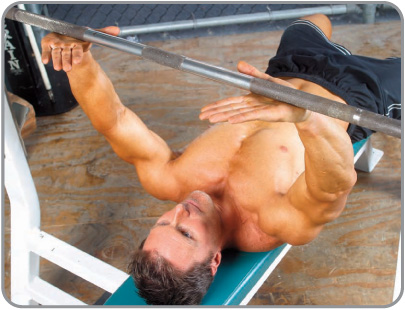
The diamond technique for getting the close grip right.
Keep your shoulder blades pinched together and your chest up. Squeeze the bar tight and imagine that you are trying to ‘tear it apart’. If you have heavy-duty rubber bands, you owe it to yourself to try the following invention of the powerlifting Westside Barbell Club. Loop the band around your wrists. Push out with your straight arms to stretch the band, unrack your barbell and do your close grips. The inward pressure from the rubber cord will force you to squeeze the bar to pulp and ‘tear it apart’.
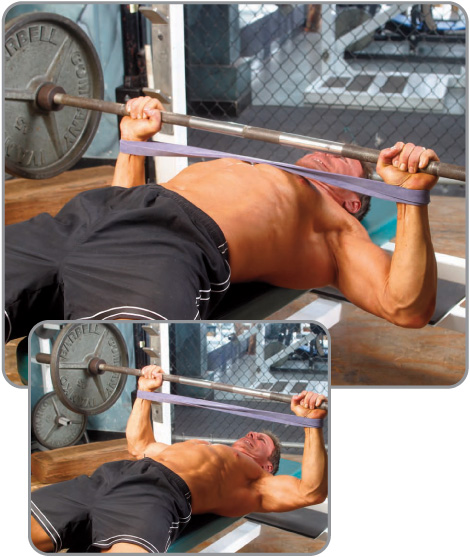
Power up your bench with a heavy-duty rubber band from JumpStretch.com.
Start with a weight you could probably press twelve times or so and do five reps. After a brief rest add ten pounds and do another five. Keep going up until you cannot get five clean reps, then work your way back down, still in fives.
Recommended sets & reps: pyramid up and down in sets of 5 reps
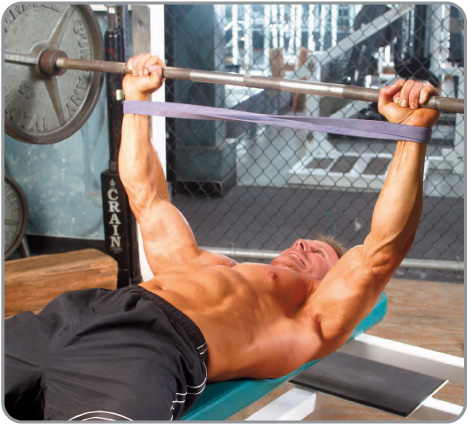
The inward pressure from the rubber cord will force you to squeeze the bar to pulp and ‘tear it apart’.
Few bodybuilders would argue that there is a better biceps builder than a heavy barbell curl. The problem is, most muscleheads curl with so much body English that only their chiropractors’ accounts see any gains.
The answer is the power rack. It deprives you of the questionably luxury of starting your curls with a swing. Park an empty barbell on safety pins inside the cage. Set up the pins at a level where your arms are almost straight when you are grabbing the barbell. Keep your shoulders down when figuring out the depth and throughout the curl.
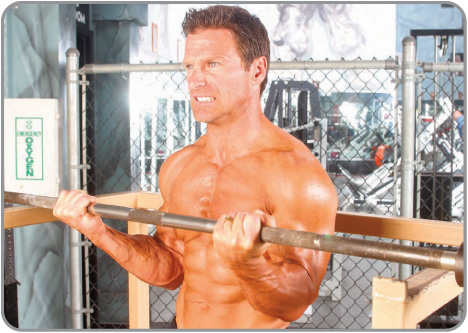
The power rack barbell curl will keep you honest.
Relax completely and let the bar rest on the pins between reps.
Load up the bar with a weight you can curl traditionally for fifteen reps or so. Stand inside the cage, take a breath, tense up, and curl. Relax completely and let the bar rest on the pins between reps. Do as many reps as you can in good form; stop before reaching failure.
Grab an upright of the power cage behind you and stretch your bis between sets. After a brief rest add five to ten pounds and do another set. And another one. Ideally, on your third set you will be able to do no more than three reps. But if you have reached the top of the pyramid in two or four sets it is okay.
Move the pins up one notch, unload the barbell and repeat the sequence. This should be plenty for your first workout. Each consecutive workout, add an extra level which translates into another three sets or so. If you find that this is too much, use good judgment and add a level every second or third workout – or even less frequently.
By the time you have worked your way up to two or three-inch partials you will have added some serious meat to your bis, not to mention some real rather than ‘swinging’ strength. And yes, finally you have a legit reason to curl inside a power cage! (You might find it amusing that S&C Coach John Davies, disgusted with bodybuilders who never use the squat rack for anything but curls, calls it ‘the curl rack’.)
Recommended sets & reps: 2-4x3-10 per level
You do not need any other curling exercise as long as you are following the above power rack curl routine. But if your arms still have some gas left – which I find highly unlikely – and you have built up tolerance to high volume training finish them off with the towel hammer curl/elbow extension superset. You may use a towel fed through the handle of a kettlebell or a rope on a low cable stack.
Start by doing strict hammer curls with a good contraction on the top and a complete extension on the bottom. Immediately turn around and do triceps extensions. Do not let your elbows flare.
Rest for no more than thirty seconds and repeat the superset. And one more time for good measure.
Recommended sets & reps: 2-3x5-10
When elite rock climber Todd Skinner met Soviet climbers for the first time on the World Cup circuit, reports Eric Hörst in Flash Training, he was amazed at their finger strength – ‘contact strength’ as they call it – and the size of their forearms. The Russians reluctantly revealed their secret: heavy barbell finger rolls.
Pick up a barbell as you would for curls; make sure the bar has rotating sleeves. Open your palms and let the bar roll down until it almost falls out of your fingers. It is a good idea to do this drill in a power rack. Bring the bar back up using your finger strength; do not flex your wrists!
The finger roll rocks.
Do six heavy sets of three to six reps resting three to five minutes between your sets twice a week. Climbers new to this exercise typically start with a poundage equal to their bodyweight, but you must keep in mind that their Popeye forearms are already supremely conditioned, so be more conservative. An eventual goal: reps with 150% of your bodyweight. Who said that forearms should be trained with high reps and sissy weights?!
The barbell finger roll is a power drill. If you find that you are too smoked from all the curls to do it heavy, move the finger rolls from your arm day to a non-pulling workout, e.g. following your legs or benches.
Recommended sets & reps: 6x3-6
Well-developed wrist extensors on top of your forearm will go a long way towards reducing the odds of elbow tendonitis. Here is an unusual way to train them.
Grab a light dumbbell in one hand or a barbell in both and lay your arms across a preacher curl bench or a similar elevation. The bar should be at your shoulder level or even higher. Now do your reverse wrist curls while keeping your elbows straight. You cannot help noticing a greater stretch on top of your forearm.
Instead of mindlessly muscling the bell up, imagine that you are performing a palm strike. Your triceps will tense up; let them.
You may do this drill between sets of finger rolls or in the end of your arm workout. Do 5x5 starting very light and build up to 5RM in a few weeks.
Recommended sets & reps: 5x5
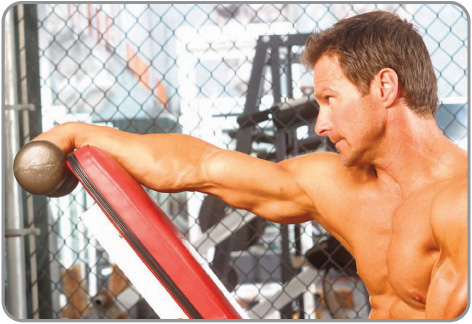
The straight arm wrist extension.
The bar should be at your shoulder level or even higher. Do your reverse wrist curls while keeping your elbows straight.
Question: My shoulders tend to come up when I curl heavy. It hurts them and I don’t feel much in my bis. Should I reduce the poundage or what?
What you need to do is push your shoulders away from your ears and lock your lats in place before curling. Then, instead of aiming to bring the bar up, visualize that you are trying to push your body into the ground by pressing away from the bar. This imagery is so critical to safe and powerful curling that I will say it again: push your rigid body straight through the ground by pressing away from the bar.
You should feel pressure in your feet and tension in your abs if you do it right. Chances are, not only will your shoulders will stop getting aggravated, your curl poundage will suddenly go up.
The Power to the People! style curl. Safety or power? – Both! Accept no compromises.
The mainstream curl. Stupid!
Question: Do I have to fully straighten out my elbows when doing curls?
Unless the exercise clearly specifies a partial range of motion (e.g. the power rack curl in this feature), the answer is yes. Failing to get a full extension leads to ‘contracture’ or loss of flexibility usually associated with aging, a lame curl 1RM, and an elbow prone to injuries during curls, pitching a ball, etc.
Straighten out your arm actively, by contracting your triceps, and stay tight on the bottom. Especially pay attention to these tips during preacher curls. These have been unjustly blamed for many tendon injuries. The blame belongs to the routine failure to extend the elbows on the bottom. The bodybuilder loses flexibility and develops an unbalanced strength curve: he is extremely weak at the very bottom because he never goes there. Then one day the muscle head hits heavy preacher curls, hits muscle failure, and the barbell boldly goes where it has never gone before – to complete elbow extension. Pop! goes the tendon and the biceps rolls up like a curtain.
Get a full extension in your curls, lower the weight with your triceps, stay tight, and do not train to failure. Long live your pipes!
Question: My elbow hurts when I do skull crushers, French presses, and similar triceps exercises. What should I do?
Provided it is not your doctor’s problem, you could try a couple of things. First, squeeze the bell hard, especially with your little and ring fingers: keep the ‘energy’ on the ‘triceps side’ of the arm. This will take some load off your elbows and make you stronger at the same time. Second, bulge your biceps when you are getting close to the bottom of the movement; this cushion should help. Third, and I hate to state the obvious, do not bounce.
And if this does not help, you have another 100 triceps exercises to choose from, so don’t sweat it if you are forced to say goodbye to one.
Question: I want to be able to do dips but I am not strong enough yet. Should I do bench dips?
Bench dips, where you park your feet on a bench and press up from another bench behind you, is one of the worst things you could do to your shoulders, short of being roughed up by a Brazilian Jiu Jitsu expert. You could tear your pecs too.
If you want to work up to dips do assisted real dips. Get a sturdy and long bungee cord (I recommend one from Jump Stretch), loop it around the parallel bars, stretch it and stand on it. Dip! The band will help you up through the hard lower half of the dip. Be careful; if the cord slips you could be heading for trouble. Keeping your abs tight will help you stay balanced.
Power to you!
Comrade, did you know that Russian wrestler and strongman Ivan Poddubny sported a pair of twenty-one inch guns nearly a century before steroids? Wouldn’t you want to learn the Russian arm training secrets?
The following Top Ten, old timers’ intuitive discoveries plus cutting edge modern research, are guaranteed to put up to two inches on your arms in just a couple of months provided you back them up with big eating and a solid nine and a half hours of sleep a night.
1. Squeeze your ‘bells to pulp when doing biceps work.
Make a fist. A white-knuckle fist! Do your feel how tension spreads from your forearm into your biceps?
According to the neurological Law of Irradiation, a contracting muscle spills its excitation over into its neighbors. Just the opposite of the silly and impossible notion of isolation, irradiation is a ‘muscle software’ that fortifies any effort. Due to an abnormally high number of nerves in your paws, anything that happens with your gripping muscles deeply affects your whole body – especially the nearby bis and tris. You can take an advantage of this powerful neural program by putting a hard squeeze on your barbells or dumbbells. The tension in the biceps will be off the charts. The result: unbelievable gains.
2. Always contract your abs and glutes when working your bis.
This bizarre maneuver also takes advantage of irradiation. In case you think that getting more juice into your arms by clenching your cheeks is preposterous try this party trick. Give your friend the hardest handshake you can muster. Shake off the tension, rest for a minute, then repeat the test. This time, in addition to trying to demolish your fellow muscle head’s claw, flex your glutes as if you are trying to pinch a coin, and brace your abs for an imaginary punch. Expect an ‘Ouch!’
In addition to powering up your curls, the ab and glute contraction will insure that you do not lean back during your curls. Power and safety, accept no compromises!
3. Lower the weights actively with your triceps.
Cramp your biceps on the top of the curl and actively lower the weight with the power of your triceps. You should feel that you are stretching a rubber band inside your bis.
Stay tight, do not relax even when you have reached the bottom – and by the bottom I mean the full elbow extension! Reverse the movement of the tightly wound muscle spring by squeezing your barbell or dumbbell.
This unusual technique dramatically improves your control of the iron, especially on the bottom of the curl ROM. Finally you shall be able to blast your muscles instead of the tendons.
4. Perform Loaded Passive Stretches for the biceps between sets.
In a nutshell – or “in a nutcase” as I used to say in my early years in America – stretching the target muscles with weights between your sets of bodybuilding exercise will make you grow.
Right after each set of a biceps drill sit on an incline bench with a pair of moderately heavy dumbbells and let them stretch out your pumped guns. Do not relax your muscles as you are instructed for conventional stretches. Do not contract them in the isometric stretch fashion; just let them be. This is the so-called ‘loaded stretching’ technique from Russia, a remarkable tool for adding muscle and power.
Stretch for ten seconds right after each set. If you take long rest periods between your sets, stretch once more a minute before the next set.
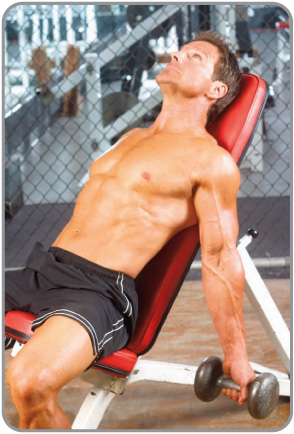
Russian loaded stretching for biceps power.
5. Periodically work both your biceps and your triceps with high sets of low reps, e.g. 10x5, not to failure.
If you boil the energetic theory of muscle hypertrophy down to gym speak, you will learn a powerfully simple growth formula. “If you get a pump while training with heavy weights you will get big.”
Both fatigue and tension need to be present to turn on the cells’ growth machinery. Fatigue is caused by high volume, or a lot of reps performed in a workout. Tension is a function of the weight. They appear to be mutually exclusive. If you say nuts to the tonnage and crank out a zillion reps with Malibu Ken and Barbie weights, you will not generate sufficient tension. If you push towards the other extreme and follow a powerlifting peaking workout of singles and doubles, near-maximal weights, and plenty of rest in between, the muscular fatigue will be minimal and the pump non-existent. And if you go to failure on all your sets, the amount of weight you can use, and therefore the tension values, will be severely compromised after the very first set.
The exact arm workout practiced by ‘show’ units of the Soviet paratroops, the ten sets of five minus muscle failure formula is your way out of this Catch-22. Relatively low repetitions enable you to handle heavier than usual poundages. And because all sets are terminated a rep or two before you bite the dust you will be able to do plenty of sets and get a great pump. Rest for one to two minutes between the sets to maximize the effect. When you have added at least an inch to your guns make sure to drop me a line on the dragondoor.com training forum.
1. Rest the weight on the base of your palm and lose the gloves.
Place the load on your hand – from a barbell, a dumbbell, a triceps pushdown bar, or even the floor if you do pushups – on the spot at the very base of your palm, below the little finger. It is the spot karate masters use for crushing their opponents or stacks of bricks.
When pressure stimulates the mechanoreceptors at that site, they send a command to the triceps to contract more intensely, as so-called positive support reaction.
The poundages on all your triceps exercises will jump upward in the very first session. You do not need to be a Ph.D. to realize that a heavier weight, lifted for the same number of repetitions, will stimulate greater strength and size gains.
It is obvious that you should not wear workout gloves in order to take advantage of this phenomenon. Senior RKC Jeff Martone quipped that a person lifting weight has as much business wearing gloves as a blind man reading Braille.
2. Do close grip bench press lockouts for the medial head
A powerlifting favorite, a four-inch close grip bench press lockout in a power rack, builds thick and ripped horseshoes without delayed gratification.
If your gym does not have a free-standing bench that you could park inside a power cage, you may lie down on the floor. Keep the tension on the tris: squeeze the bar off the pins, do not throw it or jerk it. Push your chest out and press your shoulders into the bench or floor if they are dear to you. It helps to visualize that you are pushing yourself away from the bar into the bench rather than pressing the bar up, a winning imagery from powerlifting.
3. Build the long and medial heads at once with triceps extensions/pullovers
This unusual combo enables you to handle heavy weights safely and sparks awesome growth.
Lie on the edge of a bench with a barbell – preferably an EZ bar – in your hands. A close grip is in order. Press the weight off your chest and lock out the elbows to get in the starting position.
Inhale and bend your elbows to a ninety-degree angle, as if you are about to do skull crushers. Maintaining the square elbow angle carry on the drill as a pullover. Lower the bar behind your head as deep as you can go safely. The key to preventing injuries is to keep your upper arms and forearms parallel throughout the drill. Whenever your elbows flare out your shoulders might get hurt!
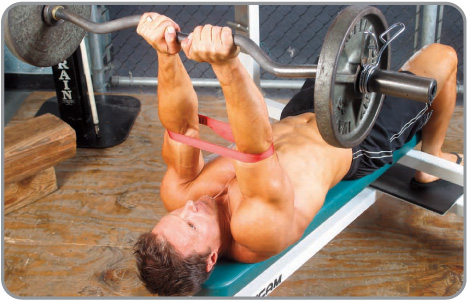
The triceps extension/pullover combo.
You don’t have to have your elbows tied but you must pretend that they are.
Keep your arms parallel. Your shoulders will thank you.
Lift the bar in the opposite order. Do not relax on the bottom and keep your lats and abs tight.
4. Rip the lateral head to shreds with the curl grip bench press
This unusual press is the numero uno exercise for the lateral head of your triceps, or the outside of your arm. It also happens to be very easy on the shoulder joint because the arms are tightly ‘screwed’ into their sockets. If you have a shoulder injury, for example torn rotator cuffs, you will appreciate this drill as an alternative to regular benches.
The curl grip BP.
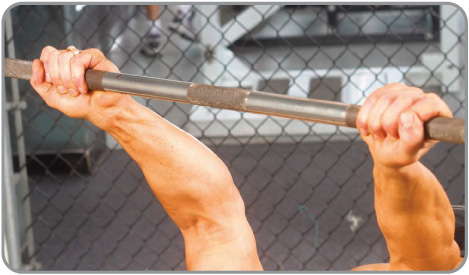
Grip the bar at the width that you find comfortable for the straight bar curl.
The reverse grip press requires more control than the regular bench press and has a different sticking point.
Start slowly and squeeze the barbell through the hard point with unhurried confidence.
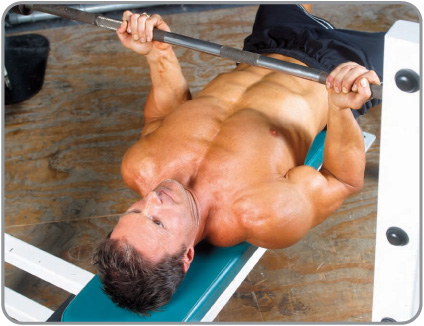
Once you have done this exercise for a month you will never go back to the weenie triceps kickbacks!
Grip the bar at the width that you find comfortable for the straight bar curl. Do not hang any plates on the bar until you find the right position. You will notice that your arms naturally go out to the sides instead of coming straight down. Turn your fingers out slightly and let the bar lie in the grooves of your hands to hit the power spot on the fleshy base of the palm and to avoid stressing out the wrists.
The reverse grip press requires more control than the regular bench press and has a different sticking point. Beware that the bar jumps off your pecs, as spry as if you were wearing a bench press shirt, and dies halfway up. The solution is not to gun the weight off your chest, in the attempt to outrun the sticking spot with momentum, but to start slowly and squeeze the barbell through the hard point with unhurried confidence.
Be certain to have a spotter who will unrack and rack the barbell for you and save you in case you lose it. Or you could do the drill alone, by pressing off the pins set in a power rack right off your chest.
Once you have done this exercise for a month you will never go back to the weenie triceps kickbacks!
5. Train your triceps heavy.
Eugene Sandow, George Hackenschmidt, and other old time Russian greats rarely if ever did high rep triceps work yet they sported symmetrical and well cut up ‘horseshoes’. These early bodybuilders instinctively knew that the triceps needed very heavy stimulation. In the second half of the twentieth century science caught up with their intuitive discovery. A study by Travill found that the brunt of the triceps work, regardless of the exercise and the loading angle, is performed by the medial head. Only when the resistance gets very heavy do the lazy lateral and long heads do kick in. Which explains why many bodybuilders, especially ladies, find it so hard to define their tris: they favor light weights and high reps in their training ‘for the burn’. The only road to a symmetrically developed triceps is through heavy weights, period. Do multiple sets of five on all your triceps drills and the DEA might knock on your door looking for juice, Comrade!
A time yellowed Russian poster shows a wide-eyed boy feeling the flexed biceps of an athlete with the letters ‘C.C.C.P.’ – the U.S.S.R. – proudly stenciled on his tightly stretched tank top. The blond giant Slav with Mr. Olympia pipes could have been a twin of the Russian boxer in Rocky IV – had he not been born half a century before Dolph Lundgren. “Do you want to be just like him?” demands the poster with Stalin’s directness, “–Then train!” Train, do not aimlessly ‘work out’. Go for the bull’s eye with vengeance and knowledge. I provide the knowledge, you the vengeance.